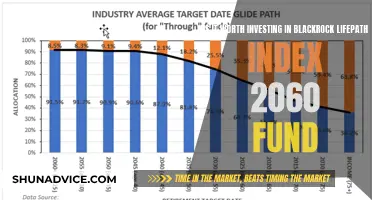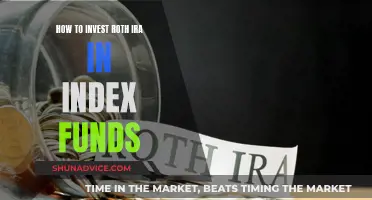
Mutual funds are a popular investment option for those looking to diversify their portfolio. Before investing, it's important to understand the minimum investment required, as this impacts the initial investment cost and potential returns. The minimum investment for a mutual fund varies depending on the fund's investment objective, management fees, and other factors. Some funds have no minimum investment requirement, while others may require a minimum initial investment of between $500 to $5,000 for retail investors. Institutional class funds and hedge funds often require minimums of $100,000 or more. It's crucial to note that mutual funds are long-term investments, and investors should carefully consider their financial goals and risk appetite before investing.
| Characteristics | Values |
|---|---|
| Minimum investment amount | Varies depending on the fund's investment objective and management fees. Can range from $0 to $5,000 or more for retail investors, and $100,000 or more for institutional investors. |
| Account type | The minimum investment amount may differ for IRA, retirement, and brokerage accounts. |
| Fund type | Open-end funds typically have higher minimum investments than closed-end funds. |
| Investment method | Lump-sum investments usually have a higher minimum amount than Systematic Investment Plans (SIPs). |
| Investor type | Higher minimum investments are often targeted at institutional investors or high-net-worth individuals, while lower minimums cater to retail investors. |
What You'll Learn

Mutual funds with no minimum investment
Mutual funds are a great way to instantly diversify your portfolio without having to buy numerous shares from different companies. While some of the best mutual funds have a minimum investment requirement of $3,000 or more, there are several funds that offer $0 minimums. Here are some of the top no-minimum mutual funds:
Fidelity Nasdaq Composite Index Fund (FNCMX)
FNCMX tracks the Nasdaq Composite Index and has an annualized return of 15.1% over the past 10 years. The fund has a low net expense ratio of 0.29%, and most of its capital is allocated toward large growth stocks, with a strong focus on the information technology sector.
Schwab International Index Fund (SWISX)
SWISX offers investors exposure to large-cap non-U.S. corporations, providing diversification for those who allocate most of their capital to U.S.-based companies. The fund offers a blend of growth and value stocks for an extremely low expense ratio of 0.06%. SWISX has its assets spread across numerous stocks, with its top position being Novo Nordisk A/S (2.3%).
BlackRock Exchange Portfolio (STSEX)
STSEX has a higher expense ratio of 0.77% but boasts excellent returns over the long run, with a 15-year annualized return of 14.1%. The fund's top three sectors are technology (35%), financial services (28%), and health care (15%). Microsoft is the top holding, comprising 34% of the fund's total assets.
Fidelity 500 Index Fund (FXAIX)
FXAIX uses the S&P 500 as its benchmark and has an impressive annualized return of 12.7% over the past 10 years, with a tiny expense ratio of 0.015%. The fund mirrors the S&P 500, so you'll find the "Magnificent Seven" stocks topping the portfolio holdings. Microsoft, Apple, Nvidia, Amazon, and Meta are the top five holdings.
Neuberger Berman Small Cap Growth Fund (NSRSX)
NSRSX is for investors willing to take on more risk and has a five-year annualized gain of 8.5%. The fund prioritizes small-cap growth stocks and has a 0.81% expense ratio. Technology, industrials, and health care are the top three sectors. The top three holdings are Rambus Inc. (4.5%), Super Micro Computer Inc. (3.6%), and e.l.f. Beauty Inc. (2.4%).
Fidelity Large Cap Growth Index Fund (FSPGX)
FSPGX aligns its holdings to mirror the total return of large-cap U.S. corporations and offers a reasonable expense ratio of 0.035%. The fund's assets are largely allocated to the "Magnificent Seven" stocks, with Microsoft, Apple, Nvidia, Amazon, and Meta leading the way. Almost half of the fund's total funds are in the technology sector.
Schwab Total Stock Market Index Fund (SWTSX)
SWTSX uses the Dow Jones U.S. Total Stock Market Index as its benchmark and charges a low expense ratio of 0.03%. The fund has 3,409 holdings, with Microsoft, Apple, Nvidia, Amazon, and Meta as its top picks. The technology sector represents 30% of the fund's total assets, followed by financial services (13%) and health care (13%).
In addition to the funds mentioned above, Fidelity offers several other mutual funds with $0 minimums, such as the Fidelity ZERO Large Cap Index Fund (FNILX), the Fidelity ZERO Extended Market Index Fund (FZIPX), the Fidelity ZERO Total Market Index Fund (FZROX), and the Fidelity ZERO International Index Fund (FZILX). These funds seek to provide investment results that correspond to the total return of a broad range of U.S. and international companies, with a 0% expense ratio and no minimums to invest.
Index Funds: Investing in Low-Cost, Diversified Portfolios
You may want to see also

Retail mutual funds minimum investment
The minimum initial investment in a mutual fund varies depending on the type of fund and the company offering it. Retail mutual funds, which are intended for ordinary investors, typically have low minimum balances, if any. Most retail mutual funds require a minimum initial investment of between $500 to $5,000. However, some funds offered by companies like Charles Schwab, Fidelity, and Vanguard have $0 minimums.
On the other hand, institutional class funds and hedge funds have much higher minimums, typically starting at $100,000 or more. These funds target larger dollar amounts from professional investors or investment firms.
It is important to note that the minimum investment amount can also vary depending on the type of account. For example, some funds have lower initial purchase amounts for IRA accounts or retirement accounts. Additionally, the minimum investment amount may be waived or reduced for investments made in a retirement account or through automatic, recurring investments.
When considering investing in mutual funds, it is essential to research the specific fund's requirements, fees, and potential returns to ensure it aligns with your investment goals and budget.
Hedge Funds: Why Investors Still Find Them Attractive
You may want to see also

Institutional class funds minimum investment
Institutional class funds are a type of mutual fund share class reserved for institutional investors. They typically have the lowest expense ratios of all the share classes in a mutual fund. The minimum investment required for institutional class funds is significantly higher than for other types of mutual funds, with most sources stating a minimum of $100,000. However, some sources state that the minimum investment for institutional shares can be as high as $200,000 or even $250,000.
Institutional class funds exist to meet the unique demands and needs of larger institutions, which differ from those of smaller investors. Institutional investors generally have much larger amounts of capital to invest and longer time horizons, allowing them to invest in illiquid assets that can generate higher returns. They also tend to face more restrictions than retail investors, as many nonprofits, for example, cannot invest in companies that profit from perceived social ills.
Institutional investors include investment managers of retirement benefit plans, endowments, foundations, government units, institutional insurance accounts, corporate institutional accounts, and institutional investment funds. They also include financial intermediaries seeking to invest for high-net-worth clients.
Institutional class funds offer a range of benefits, including lower expense ratios and the ability to invest in a more diverse range of assets. However, the high minimum investment required for these funds means that they are out of reach for most individual investors.
Index Fund Investing: Financial Independence Strategy
You may want to see also

Open-end funds vs closed-end funds
The minimum initial investment in a mutual fund varies depending on the type of fund and the company offering it. Some mutual funds let investors buy in with no minimum at all, meaning that even $5 or $10 can be enough to get started. However, most retail mutual funds require a minimum initial investment ranging from $500 to $5,000, with institutional-class funds and hedge funds requiring a minimum of $100,000 or more. Some providers that offer funds with low or no minimum investment include Charles Schwab, American Funds, and Fidelity.
Now, here's an overview of open-end funds vs closed-end funds:
Open-end funds and closed-end funds are two types of mutual funds with distinct characteristics. Here are the key differences between the two:
Nature
Open-end funds do not have a fixed number of shares and are "open" to new investments. They create new shares when someone buys and remove shares from circulation when someone sells. On the other hand, closed-end funds have a fixed number of shares issued through an initial public offering (IPO) and then traded on the stock exchange. No new shares are created or bought back by the fund.
Pricing
Open-end funds are bought and sold at their net asset value (NAV), which is calculated at the end of each trading day. As a result, they can only be bought and sold at the end of the day. In contrast, closed-end funds trade throughout the day, and their prices fluctuate based on supply and demand. They often trade at a premium or discount to their NAV.
Management
Both open-end and closed-end funds are professionally managed and can provide diversified portfolios. However, closed-end funds are usually actively managed and tend to focus on a specific industry, sector, or region.
Availability
Open-end funds are more common and widely available than closed-end funds. Investors can typically purchase open-end funds through an online broker or directly from the fund company. In contrast, closed-end funds are traded on exchanges, and investors need to buy shares from existing investors.
Examples
Most mutual funds are open-end funds. Exchange-traded funds (ETFs) can be structured as either open-end or closed-end funds. Municipal bond funds and some global investment funds are commonly closed-end funds.
Credit Investment Funds: Understanding the Basics
You may want to see also

Mutual fund fees
- Account service fees: These are fees charged by the brokerage firm for maintaining your account. For example, Vanguard charges a $25 account service fee for each brokerage account, which can be waived under certain conditions, such as having a certain amount of assets or signing up for e-delivery of statements and other documents.
- Purchase and redemption fees: Some funds charge a fee when you buy or sell shares, or within a specific time period, to discourage short-term trading and help cover transaction costs. These fees typically range from 0.25% to 1.00% of the transaction amount.
- Expense ratio: This is the annual fee charged by the fund for management and other operating expenses, expressed as a percentage of the fund's average net assets. It includes management, administrative, marketing, and distribution fees. A low-cost fund like Vanguard has an average expense ratio of 0.09%, while the industry average is 0.50%.
- Sales loads or commissions: These are sales charges or commissions paid to the broker or salesperson who sold the fund, which are usually passed on to the investor. There are front-end loads, charged when you buy fund shares, and back-end loads, charged when you redeem or sell fund shares. Back-end loads typically decline over time and may disappear if the investor holds the shares for a certain period.
- Transaction fees: Mutual fund investors may also face transaction fees from their brokerage account, in addition to the fees charged by the fund itself.
It's important to carefully review the fee structure of a mutual fund before investing, as these fees can impact your overall returns. Some funds, like Vanguard, offer commission-free trading of their ETFs and mutual funds, as well as those of other companies. Additionally, some funds may have higher minimum investment requirements to protect against short-term trading activity.
Investment vs Mutual Funds: What's the Difference?
You may want to see also
Frequently asked questions
The minimum initial investment in a mutual fund varies depending on the fund. Some mutual funds let investors buy in with no minimum at all, meaning that even $5, $10, or $100 can be enough to get started. However, most retail mutual funds require a minimum initial investment of between $500 to $5,000, with institutional class funds and hedge funds requiring minimums of at least $100,000 or more.
The minimum initial investment for a mutual fund depends on various factors, including the fund's investment objective, management fees, and the type of investor the fund is targeted towards. For example, funds geared towards institutional investors or high-net-worth individuals typically have higher minimum investment requirements.
Yes, there are a few different ways to invest in mutual funds, including new fund offers (NFOs), lump-sum investments, and systematic investment plans (SIPs). NFOs are similar to IPOs, where the fund collects fresh capital from the public at a unit value of Rs.10. Lump-sum investments involve investing a large amount of money at once, while SIPs allow investors to contribute a fixed amount at regular intervals.







